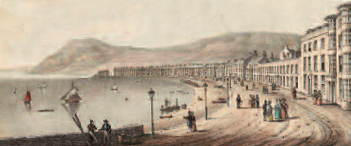
Discover Your Ancestors
Two critically acclaimed publications are available to family history researchers - the annual print magazine, Discover Your Ancestors, and the monthly online magazine, Discover Your Ancestors Periodical. Click here to subscribe.Cardiganshire

Cardiganshire – or, more properly now, Ceredigion – is a county in mid Wales, mostly rural but with an important coastline.
Ceredigion has been inhabited since prehistoric times: 170 hill forts and enclosures have been identified across the county and there are many standing stones dating back to the Bronze Age. Around the time of the Roman invasion of Britain, the area was between the realms of the Demetae and Ordovices, with Roman gold mines near present-day Llelio. The 9th century History of the Britons attributed to Nennius records that Cunedda’s son Ceredig settled the area around the river Teifi in the 5th century.
In the Middle Ages, it was a minor kingdom also known for a time as Seisyllwg. Following its Norman conquest, the name was anglicised to Cardigan and then Cardiganshire (in Welsh the county was called Sir Aberteifi, Aberteifi being the Welsh name for the town of Cardigan) and it began to be administered as a county in 1282. The historic county was abolished in 1974 before being reconstituted in 1996 under the name Ceredigion. The largest town is Aberystwyth, home to the National Library of Wales.
More than half the population of the county speaks the Welsh language today and the region is considered a centre of Welsh culture.
At one time, Ceredigion had more industry than it does today. Lead, silver and zinc were mined here, and its former seat at Cardigan was the principal port of southern Wales before the silting of its harbour in the mid-19th century. The economy then became almost completely dependent on dairy produce and the rearing of livestock, sent to the English market.
Many pilgrims passed through Cardiganshire on their way to St David’s. Some came by sea and made use of the churches at Mwnt and Penbryn, while others came by land seeking hospitality at such places as Strata Florida Abbey. Place names including ‘ysbyty’ denote their association with pilgrims.
In 1282, Edward I of England conquered the principality of Wales and divided the area into counties. One of 13 traditional counties in Wales, Cardiganshire was split into the five hundreds of Genau’r-Glyn, Ilar, Moyddyn, Penarth and Troedyraur.
In the 18th century there was an evangelical revival of Christianity, and Nonconformism became established in the county as charismatic preachers like Daniel Rowland of Llangeitho attracted large congregations. Every community built its own chapel or meeting house, and Cardiganshire became one of the centres of Methodism in Wales, the Aeron Valley in particular.
The Industrial Revolution largely passed the area by. In the uplands, wheeled vehicles were rare in the 18th century, and horses and sleds were still being used for transport. On the coast, trade in herrings and corn took place across the Irish Sea. In the 19th century, many of the rural poor emigrated to the New World from Cardigan, between five and six thousand leaving the town between 1790 and 1860. Aberystwyth became the main centre for the export of lead and Aberaeron and Newquay did brisk coastal trade. The building of the railway from Shrewsbury in the 1860s encouraged visitors and hotels sprang up in the town.
Exclusive census analysis from the data at TheGenealogist.co.uk reveals that common Cardiganshire surnames, as distinct from Wales as a whole, include Morgans, Richards and Richard in 1841, and Morgans still in 1911. The top five surnames overall in the county (and indeed all of Wales) remained the same in both years: Jones, Davies, Evans, Thomas and Williams.
Ceredigion Records Online
Leading data website TheGenealogist.co.uk has a wealth of records for Cardiganshire. Here is a quick run-down of what you can find (in addition to national collections):
- Trade directories: three directories covering South Wales from 1835 to 1938.
- Census records: Cardiganshire records for every census from 1841 to 1911.
- Nonconformist registers: Nonconformist chapels and meeting houses across Cardiganshire are covered in the site’s collections.
- Land owners: the site’s huge collection of tithe commutation records includes the county, along with tithe maps; plus an 1873 survey of Welsh and English landowners includes the region.
- Wills: many people from Cardiganshire can be found in Prerogative Court of Canterbury (PCC) Wills 1384-1858.